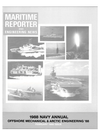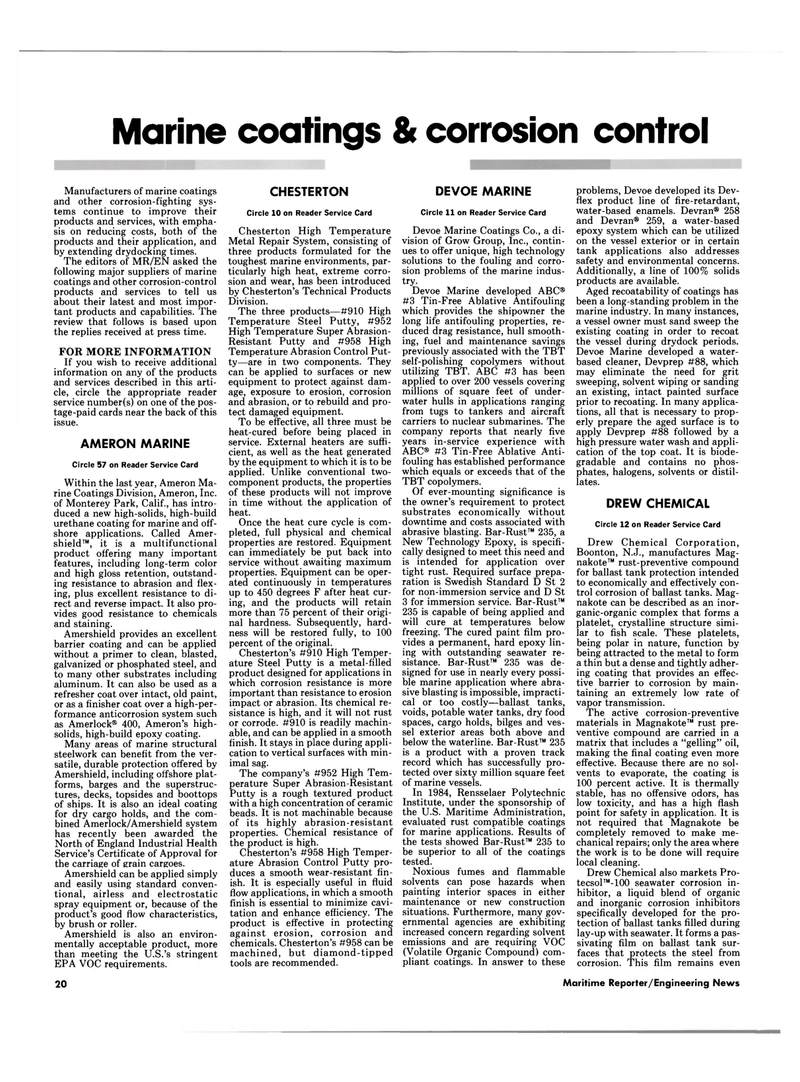
Page 18: of Maritime Reporter Magazine (February 1988)
Read this page in Pdf, Flash or Html5 edition of February 1988 Maritime Reporter Magazine
Marine coatings & corrosion control
Manufacturers of marine coatings and other corrosion-fighting sys- tems continue to improve their products and services, with empha- sis on reducing costs, both of the products and their application, and by extending drydocking times.
The editors of MR/EN asked the following major suppliers of marine coatings and other corrosion-control products and services to tell us about their latest and most impor- tant products and capabilities. The review that follows is based upon the replies received at press time.
FOR MORE INFORMATION
If you wish to receive additional information on any of the products and services described in this arti- cle, circle the appropriate reader service number(s) on one of the pos- tage-paid cards near the back of this issue.
AMERON MARINE
Circle 57 on Reader Service Card
Within the last year, Ameron Ma- rine Coatings Division, Ameron, Inc. of Monterey Park, Calif., has intro- duced a new high-solids, high-build urethane coating for marine and off- shore applications. Called Amer- shield™, it is a multifunctional product offering many important features, including long-term color and high gloss retention, outstand- ing resistance to abrasion and flex- ing, plus excellent resistance to di- rect and reverse impact. It also pro- vides good resistance to chemicals and staining.
Amershield provides an excellent barrier coating and can be applied without a primer to clean, blasted, galvanized or phosphated steel, and to many other substrates including aluminum. It can also be used as a refresher coat over intact, old paint, or as a finisher coat over a high-per- formance anticorrosion system such as Amerlock® 400, Ameron's high- solids, high-build epoxy coating.
Many areas of marine structural steelwork can benefit from the ver- satile, durable protection offered by
Amershield, including offshore plat- forms, barges and the superstruc- tures, decks, topsides and boottops of ships. It is also an ideal coating for dry cargo holds, and the com- bined Amerlock/Amershield system has recently been awarded the
North of England Industrial Health
Service's Certificate of Approval for the carriage of grain cargoes.
Amershield can be applied simply and easily using standard conven- tional, airless and electrostatic spray equipment or, because of the product's good flow characteristics, by brush or roller.
Amershield is also an environ- mentally acceptable product, more than meeting the U.S.'s stringent
EPA VOC requirements.
CHESTERTON
Circle 10 on Reader Service Card
Chesterton High Temperature
Metal Repair System, consisting of three products formulated for the toughest marine environments, par- ticularly high heat, extreme corro- sion and wear, has been introduced by Chesterton's Technical Products
Division.
The three products—#910 High
Temperature Steel Putty, #952
High Temperature Super Abrasion-
Resistant Putty and #958 High
Temperature Abrasion Control Put- ty—are in two components. They can be applied to surfaces or new equipment to protect against dam- age, exposure to erosion, corrosion and abrasion, or to rebuild and pro- tect damaged equipment.
To be effective, all three must be heat-cured before being placed in service. External heaters are suffi- cient, as well as the heat generated by the equipment to which it is to be applied. Unlike conventional two- component products, the properties of these products will not improve in time without the application of heat.
Once the heat cure cycle is com- pleted, full physical and chemical properties are restored. Equipment can immediately be put back into service without awaiting maximum properties. Equipment can be oper- ated continuously in temperatures up to 450 degrees F after heat cur- ing, and the products will retain more than 75 percent of their origi- nal hardness. Subsequently, hard- ness will be restored fully, to 100 percent of the original.
Chesterton's #910 High Temper- ature Steel Putty is a metal-filled product designed for applications in which corrosion resistance is more important than resistance to erosion impact or abrasion. Its chemical re- sistance is high, and it will not rust or corrode. #910 is readily machin- able, and can be applied in a smooth finish. It stays in place during appli- cation to vertical surfaces with min- imal sag.
The company's #952 High Tem- perature Super Abrasion-Resistant
Putty is a rough textured product with a high concentration of ceramic beads. It is not machinable because of its highly abrasion-resistant properties. Chemical resistance of the product is high.
Chesterton's #958 High Temper- ature Abrasion Control Putty pro- duces a smooth wear-resistant fin- ish. It is especially useful in fluid flow applications, in which a smooth finish is essential to minimize cavi- tation and enhance efficiency. The product is effective in protecting against erosion, corrosion and chemicals. Chesterton's #958 can be machined, but diamond-tipped tools are recommended.
DEVOE MARINE
Circle 11 on Reader Service Card
Devoe Marine Coatings Co., a di- vision of Grow Group, Inc., contin- ues to offer unique, high technology solutions to the fouling and corro- sion problems of the marine indus- try.
Devoe Marine developed ABC® #3 Tin-Free Ablative Antifouling which provides the shipowner the long life antifouling properties, re- duced drag resistance, hull smooth- ing, fuel and maintenance savings previously associated with the TBT self-polishing copolymers without utilizing TBT. ABC #3 has been applied to over 200 vessels covering millions of square feet of under- water hulls in applications ranging from tugs to tankers and aircraft carriers to nuclear submarines. The company reports that nearly five years in-service experience with
ABC® #3 Tin-Free Ablative Anti- fouling has established performance which equals or exceeds that of the
TBT copolymers.
Of ever-mounting significance is the owner's requirement to protect substrates economically without downtime and costs associated with abrasive blasting. Bar-Rust™ 235, a
New Technology Epoxy, is specifi- cally designed to meet this need and is intended for application over tight rust. Required surface prepa- ration is Swedish Standard D St 2 for non-immersion service and D St 3 for immersion service. Bar-Rust™ 235 is capable of being applied and will cure at temperatures below freezing. The cured paint film pro- vides a permanent, hard epoxy lin- ing with outstanding seawater re- sistance. Bar-Rust™ 235 was de- signed for use in nearly every possi- ble marine application where abra- sive blasting is impossible, impracti- cal or too costly—ballast tanks, voids, potable water tanks, dry food spaces, cargo holds, bilges and ves- sel exterior areas both above and below the waterline. Bar-Rust™ 235 is a product with a proven track record which has successfully pro- tected over sixty million square feet of marine vessels.
In 1984, Rensselaer Polytechnic
Institute, under the sponsorship of the U.S. Maritime Administration, evaluated rust compatible coatings for marine applications. Results of the tests showed Bar-Rust™ 235 to be superior to all of the coatings tested.
Noxious fumes and flammable solvents can pose hazards when painting interior spaces in either maintenance or new construction situations. Furthermore, many gov- ernmental agencies are exhibiting increased concern regarding solvent emissions and are requiring VOC (Volatile Organic Compound) com- pliant coatings. In answer to these problems, Devoe developed its Dev- flex product line of fire-retardant, water-based enamels. Devran® 258 and Devran® 259, a water-based epoxy system which can be utilized on the vessel exterior or in certain tank applications also addresses safety and environmental concerns.
Additionally, a line of 100% solids products are available.
Aged recoatability of coatings has been a long-standing problem in the marine industry. In many instances, a vessel owner must sand sweep the existing coating in order to recoat the vessel during drydock periods.
Devoe Marine developed a water- based cleaner, Devprep #88, which may eliminate the need for grit sweeping, solvent wiping or sanding an existing, intact painted surface prior to recoating. In many applica- tions, all that is necessary to prop- erly prepare the aged surface is to apply Devprep #88 followed by a high pressure water wash and appli- cation of the top coat. It is biode- gradable and contains no phos- phates, halogens, solvents or distil- lates.
DREW CHEMICAL
Circle 12 on Reader Service Card
Drew Chemical Corporation,
Boonton, N.J., manufactures Mag- nakote™ rust-preventive compound for ballast tank protection intended to economically and effectively con- trol corrosion of ballast tanks. Mag- nakote can be described as an inor- ganic-organic complex that forms a platelet, crystalline structure simi- lar to fish scale. These platelets, being polar in nature, function by being attracted to the metal to form a thin but a dense and tightly adher- ing coating that provides an effec- tive barrier to corrosion by main- taining an extremely low rate of vapor transmission.
The active corrosion-preventive materials in Magnakote™ rust pre- ventive compound are carried in a matrix that includes a "gelling" oil, making the final coating even more effective. Because there are no sol- vents to evaporate, the coating is 100 percent active. It is thermally stable, has no offensive odors, has low toxicity, and has a high flash point for safety in application. It is not required that Magnakote be completely removed to make me- chanical repairs; only the area where the work is to be done will require local cleaning.
Drew Chemical also markets Pro- tecsol™-100 seawater corrosion in- hibitor, a liquid blend of organic and inorganic corrosion inhibitors specifically developed for the pro- tection of ballast tanks filled during lay-up with seawater. It forms a pas- sivating film on ballast tank sur- faces that protects the steel from corrosion. This film remains even 20 Maritime Reporter/Engineering News

 17
17

 19
19
